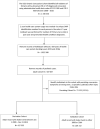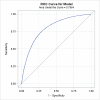Prediction of risk of prolonged post-concussion symptoms: Derivation and validation of the TRICORDRR (Toronto Rehabilitation Institute Concussion Outcome Determination and Rehab Recommendations) score
- PMID: 34237056
- PMCID: PMC8266123
- DOI: 10.1371/journal.pmed.1003652
Prediction of risk of prolonged post-concussion symptoms: Derivation and validation of the TRICORDRR (Toronto Rehabilitation Institute Concussion Outcome Determination and Rehab Recommendations) score
Abstract
Background: Approximately 10% to 20% of people with concussion experience prolonged post-concussion symptoms (PPCS). There is limited information identifying risk factors for PPCS in adult populations. This study aimed to derive a risk score for PPCS by determining which demographic factors, premorbid health conditions, and healthcare utilization patterns are associated with need for prolonged concussion care among a large cohort of adults with concussion.
Methods and findings: Data from a cohort study (Ontario Concussion Cohort study, 2008 to 2016; n = 1,330,336) including all adults with a concussion diagnosis by either primary care physician (ICD-9 code 850) or in emergency department (ICD-10 code S06) and 2 years of healthcare tracking postinjury (2008 to 2014, n = 587,057) were used in a retrospective analysis. Approximately 42.4% of the cohort was female, and adults between 18 and 30 years was the largest age group (31.0%). PPCS was defined as 2 or more specialist visits for concussion-related symptoms more than 6 months after injury index date. Approximately 13% (73,122) of the cohort had PPCS. Total cohort was divided into Derivation (2009 to 2013, n = 417,335) and Validation cohorts (2009 and 2014, n = 169,722) based upon injury index year. Variables selected a priori such as psychiatric disorders, migraines, sleep disorders, demographic factors, and pre-injury healthcare patterns were entered into multivariable logistic regression and CART modeling in the Derivation Cohort to calculate PPCS estimates and forward selection logistic regression model in the Validation Cohort. Variables with the highest probability of PPCS derived in the Derivation Cohort were: Age >61 years ([Formula: see text] = 0.54), bipolar disorder ([Formula: see text] = 0.52), high pre-injury primary care visits per year ([Formula: see text] = 0.46), personality disorders ([Formula: see text] = 0.45), and anxiety and depression ([Formula: see text] = 0.33). The area under the curve (AUC) was 0.79 for the derivation model, 0.79 for bootstrap internal validation of the Derivation Cohort, and 0.64 for the Validation model. A limitation of this study was ability to track healthcare usage only to healthcare providers that submit to Ontario Health Insurance Plan (OHIP); thus, some patients seeking treatment for prolonged symptoms may not be captured in this analysis.
Conclusions: In this study, we observed that premorbid psychiatric conditions, pre-injury health system usage, and older age were associated with increased risk of a prolonged recovery from concussion. This risk score allows clinicians to calculate an individual's risk of requiring treatment more than 6 months post-concussion.
Conflict of interest statement
The authors have declared no competing interests.
Figures






References
-
- Center for Disease Control and Prevention (CDC) National Center for Injury Prevention and Control. Report to Congress on mild traumatic brain injury in the United States: steps to prevent a serious public health problem. 2003.
-
- Iverson GL. Outcome from mild traumatic brain injury. Curr Opin Psychiatry. 2005;18:301–17. doi: 10.1097/01.yco.0000165601.29047.ae - DOI - PubMed
Publication types
MeSH terms
LinkOut - more resources
Full Text Sources

